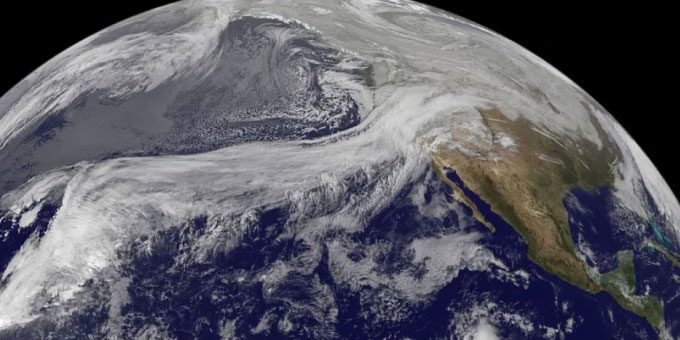American Scientists Discover Atmospheric Rivers Shifting Toward the Poles Over the Past 40 Years, Causing Significant Changes in Global Weather.
In recent decades, atmospheric rivers, which transport water vapor in the upper atmosphere of Earth, have changed their positions— a fundamental shift that could affect weather patterns and rainfall across the planet.

A satellite captures a view of the Pacific Ocean with clouds illustrating the movement of the atmospheric river “Pineapple Express” heading toward the West Coast of the United States. (Photo: GOES-11/NASA)
Scientists at the University of California, Santa Barbara (UCSB) have observed that atmospheric rivers in both hemispheres have shifted approximately 6° to 10° toward the poles over the past 40 years. This means that areas affected by this phenomenon are now located further north in the Northern Hemisphere and further south in the Southern Hemisphere than before. The study was published in the journal Science Advances.
The research team explains that the underlying cause of this shift is the cooling of the eastern tropical Pacific over the past four decades, although they note that this series of events “still needs to be fully explored.”
Atmospheric rivers are streams of water vapor flowing in Earth’s atmosphere, significantly impacting rainfall and snowfall. Their size and intensity can vary widely, but on average, an atmospheric river can carry a volume of water vapor equivalent to the flow of the Mississippi River at its mouth.
One of the most well-known atmospheric rivers is called “Pineapple Express,” a powerful atmospheric river that transports moisture from the tropical Pacific around Hawai’i to the west coast of the United States and Canada. When this moist and warm air mass reaches the West Coast, it can cause significant rainfall across California, as well as Oregon, Washington, and British Columbia.
It is estimated that about 50% of the rainfall and snowfall on the West Coast of the United States is delivered by atmospheric rivers. However, they are not just a phenomenon in North America; atmospheric rivers affect weather and rainfall distribution globally.
(Graphic: Next).
The new study indicates that the recent shift of atmospheric rivers toward the poles could have profound effects on global weather systems in the coming years.
Regions that previously relied on atmospheric rivers for rainfall may face increased drought and heatwave conditions, while areas at higher latitudes may experience greater rainfall, stronger storms, and an increased risk of flooding.
For a region like Southern California, the northward movement of atmospheric rivers could further reduce rainfall, leading to more issues with water scarcity, drought, and wildfires. Meanwhile, areas like the Pacific Northwest may see wetter weather, resulting in problems such as flooding.
However, much remains unknown about the broader impacts of atmospheric rivers shifting toward the poles. One concern is that this could lead to unpredictable consequences for the world’s oceans.




















































